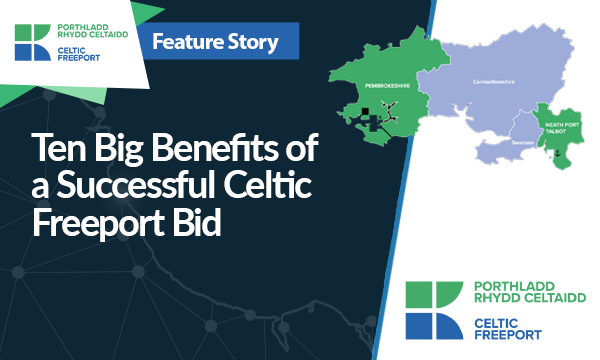Freeports are areas of operational and development land linked to a port, where normal tax and customs rules are varied to promote growth and trade.
Imports can enter freeports with simplified customs documentation and without attracting tariffs.
Businesses operating inside designated areas within the freeport can use these imports to manufacture other products. These products can either be exported without ever facing the full tariffs or procedures (subject to trade agreements) or they can be shipped to another part of the country, when they would be subject to the full import process, including paying any tariffs.
A modern UK freeport can comprise a mixture of digitally linked, discreet customs and tax sites.
The aim of freeports is to drive investment into deprived communities to help increase employment opportunities and boost economic activity in the area.
What are the key areas of a freeport?
There are several key areas that make up a freeport. These are:
- The freeport impact zone
- The outer boundary
- Tax sites
- Customs sites
1. Freeport impact zone
- Indicates the area that is expected to benefit most directly from the freeport's economic impacts.
2. Freeport outer boundary
- The outer boundary is the physical limit of the freeport. All freeport measures (e.g. tax, customs, spending) must be within this boundary. Only specifically designated sites within the boundary will benefit from the new business investment and customs incentives.
- The boundary is typically 45km. The Celtic Freeport takes an alternative ‘corridor’ approach, with two primary locations working together. One around the Port of Milford Haven and another around Port Talbot, thus representing the best value for Wales and the UK.
3. Tax sites
- These are specific areas within the boundary that benefit from tax incentives to promote business investment.
- Up to three tax sites can be designated within a freeport. Individual tax sites should be between 20-200 hectares and a contiguous area.
- Tax-site land must be ‘underdeveloped,’ i.e. empty, brownfield or under-utilised land. Tax sites do not have to be on port-owned land.
4. Customs sites
- These are specific areas within the boundary where businesses can benefit from simplified customs arrangements.
- A customs site can also be a tax site but does not have to be.
Who selects a freeport?
- In early spring 2023, the Welsh and UK governments will jointly evaluate all bids and select a freeport for Wales.
- This is a joint process as the modern freeport model encapsulates a suite of policies that straddles both UK and devolved policy areas.
- This is a competitive bidding process, which started in September 2022. The deadline for bids was 24 November 2022.
- Currently, England has eight freeports and Scotland is due to unveil their two selected bids for green freeports in Q4 2022.
What incentives are being proposed for Welsh freeports?
Tax
- 100% business-rate relief for five years.
- 100% enhanced Capital Allowances for the first year of qualifying expenditure.
- Employers forego NIC contributions on salaries up to £25,000 for new hires in first three years.
- 10% rate of structures and buildings allowance per annum for 10 years on renovation or construction.
- Land purchases on tax sites benefit from 100% Stamp Duty Land Tax Relief
Customs
- Duty deferral automatically granted within customs zones until goods leave site.
- Automatic duty inversion for goods entering customs zones with higher tariff than final product.
- Customs duty exemption on imported goods processed in the freeport and re-exported.
- The VAT on goods entering the freeport is suspended.
- Freeports are authorised to use simplified import procedures
Investment and spending
- £25m in seed capital for the freeport to improve infrastructure within its boundary.
- Freeport local authorities retain 100% of Business Rates revenues for 25 years. Local authorities can borrow against future Business Rates revenue to invest upfront in infrastructure and skills programmes.
Innovation and regulation
- Regulatory sandboxes can be applied for to relax specific regulations and support new areas of research and development (e.g. drone flights and automated vehicles). A freeport collaboration hub can be used as a platform to create regional innovation hubs.
Planning support
- Use of Permitted Development Rights by seaports.
Who is behind the Celtic Freeport bid?
The bid is a private-public sector partnership led by Associated British Ports (ABP), Neath Port Talbot Council, Pembrokeshire County Council and the Port of Milford Haven.
The bid was developed with strong input from renewables developers, energy companies, industrial complexes, innovation assets, academic institutions and education providers.
Will Pembrokeshire Coast National Park be impacted by the Celtic Freeport?
No. The proposed Celtic Freeport outer boundary excludes the Pembrokeshire Coast National Park.
This area is categorically not identified for development, now or in the future, nor will it receive any special planning or regulatory status that may encourage development.
How could the Celtic Freeport benefit Wales and the UK?
The Celtic Freeport will help to support economic growth in Wales and the UK, and will support the delivery of a cleaner, greener and more energy-independent Britain.
Key benefits include:
- The creation of over 16,000 new jobs.
- The generation of up to £5.5 billion of new investment.
- Unlocking a UK market in the construction and maintenance of floating offshore wind (FLOW) projects, worth over £54 billion.
- Facilitating the acceleration of:
- Wales’ path to net zero
- the re-industrialisation of Wales
- the roll-out of FLOW, the hydrogen economy, marine energy and sustainable fuel production
- up to £1.4 billion in port infrastructure at two new energy ports and factories to secure first-move advantage in the global FLOW market
- new export opportunities
- Wales-wide benefits across new supply chains
- the creation of new green skills pathways for young people
- the creation of a 25-year legacy through retained business rates (c£0.5 billion) in an area with the nation's highest child poverty rates.
What will the Celtic Freeport mean for Wales?
With advanced manufacturing, innovation and growth as central tenets of the ambition, the Celtic Freeport is about creating new opportunities.
Building on the extensive regional specialist skill base, transmission and pipelines, natural capital and distribution facilities, the Celtic Freeport will provide the skills, services and spaces for industry to thrive.
The Celtic Freeport has a natural affinity towards energy. The ambitions are to help unlock Wales’ Celtic Sea Floating Offshore Wind (FLOW) opportunity, support emerging opportunities in the hydrogen economy, enable the industrial transition towards low-carbon energy systems, fuels and power generation, and support the growth of effective energy distribution and transportation models.
The opportunity is not restricted to the energy sector, as industries across the blue and green economies are also well positioned to benefit from the Celtic Freeport’s potential.
The bid proposes to pool and re-invest 25 years’ worth of non-domestic business rates growth (c£500m) through a number of measures, including the South Wales Industrial Transition from Carbon Hub (SWITCH), online adult learning programmes and the Regional Learning and Skills Partnership for South West Wales.
For Wales, this all adds up to an accelerated pathway to net zero, greater productivity, resilience for existing industries and their supply chains, enhanced export potential, greater energy security and more prosperous and enriched communities.






